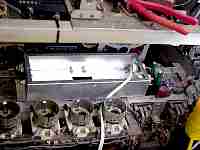
global top page |site top page |Begin Transmitter Examination|Previous Page|Next Page

|
The 304TH and 304TL tubes are increasingly rare, and very expensive.
Out of five bought from various people at hamfests, with the promises of:
"sure it's good!, checked it myself"
"I would'nt sell ya no bad tubes, yuk yuk.."
"sellin' it for a friend, he said it's a good 'un.."
Four were bad. (shorted filament to grid, or flashover at high voltage -thanks, jerks!).
Rather than keep paying these COBs (Crafty Old Buzzards) for 'display tubes', I decided to use a pair of new 3-500Z tubes. These are still made in China and elsewhere, and will be so for the foreseeable future. I bought them and a pair of sockets from a reputable dealer (ESRC) with a 1 year warranty which starts not when I purchased them, but when I first fire them up.
In order to make the change to the 3-500Z's, a blower and pressurized chassis would have to be added to the transmitter. The challenge would be to find a box large enough to carry the sockets which are 4.5" diameter, and yet small enough to fit in the space allowed (about 6"x11"x3").
The blower, the same size as the one used for the 4-1000A final, was fitted with its outlet between the rails which used to mount the brackets of the 304TH sockets. One of the 304TH's 5V 25A filament transformers was removed to make room for the blower. The remaining one, although rated only 25A and not 29A (as would be required for a pair of 3-500Z tubes) has been found to be so sufficiently well built that there is no appreciable heating after an hour of use. This re-affirms the high levels of quality almost always found in very old American-made electronics parts.
The top of the chassis may need to be removed from time to time, so the wiring to each side of the filaments is made of some very flexible 3-conductor AC power cable, wherein each conductor is 16 guage, so it's 16x3. The pair of these flat cables goes to the center of a set of #10 solid copper wires connected between filament pins of the respective sockets. The measured voltage at the sockets is right at 5VAC with 118VAC at the filament transformer primary connections. A piece of the same flat wire is used to connect the grid terminals of the chassis to the grid terminals of the tube sockets. This way, none of the wiring is never stressed if the chassis top is removed. Additionally, it is hoped that since the grid wiring is a set of parallel conductors, the chance of differential hum pickup is minimized.
Two of four bolts can be seen next to a rectangular cutout in the bottom of the chassis. These bolts hold the blower and chassis in place on the rails.
I'll digress briefly on the subject of large tubes and hamfests: I nearly got skewered on a 4-1000, where the guy was "selling it for a friend", the guy said that the friend said it "worked great", and he wanted $120, despite alot of discoloration on the glass, showing it had at least a good amount of use on it. I remarked about the discoloration, and asked if he would guarantee it to put out at least 700 watts at 3KV (easy for a good used 4-1000), and provide ID for good faith, and, well whaddaya know.. He didn't want to identify himself, the price quickly dropped to $60 and then after I said no thanks and began to walk away, $40. Now, why would that be? $40 for a "good" 4-1000A? Too good to be true. Hmm... Maybe the tube was BAD, the mysterious 'friend' did not exist, and the guy was out to dispose of a junk tube he found in the trashpile somewhere. Buyer Beware! Anyway, back to the Tucker KW.
Page 32